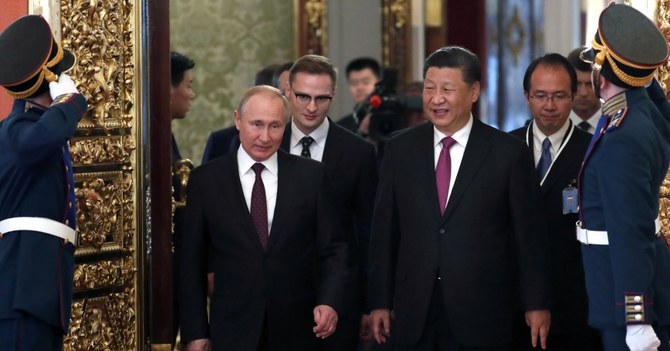Russia and China are reshaping Eurasia as the center of a new global order

https://arab.news/pjnme
Last year, as the world reeled from the ravages of the pandemic, it saw the consolidation of a strategic alignment that has made Russia and China partners in an ambitious enterprise: The reshaping of Eurasia at the heart of a new world order.
Believing that Western powers are intent on weakening Russia through regime change initiatives at its borders, President Vladimir Putin first envisaged a “Eurasian Union” in 2011. This was institutionalized in the Eurasian Economic Union in 2015. Besides Russia, its members are Armenia, Belarus, Kazakhstan and Kyrgyzstan.
In September 2013, meanwhile, Chinese President Xi Jinping set out his Belt and Road Initiative (BRI), which envisages land and sea connectivity from the Pacific to the Atlantic through transport linkages.
In May 2015 Putin and Xi agreed to make their two Eurasian visions complementary. A year later, the former declared his intention to establish a Greater Eurasian Partnership across Asia and Europe.
Among the major Eurasian countries that have built substantial ties with Russia and China is Turkey. In addition to establishing a significant defense relationship through Turkey’s purchase of the Russian-made S-400 missile system, the two countries are working together in Syria. And although they are on opposite sides in Libya, they are consulting closely on matters relating to that country as well.
Turkey is also a major recipient of Chinese investment and an increasingly important partner in BRI and digital connectivity projects. The two countries are also discussing the possibility of linking BRI with Turkey’s Middle Corridor initiative, which envisages road and railway connectivity to China through the Caucasus and Central Asia.
Afghanistan and Pakistan are the other nations that are becoming a part of the Eurasian enterprise. Under the China-Pakistan Economic Corridor, which is part of BRI, energy, industry and infrastructure projects valued at $60 billion are being pursued in Pakistan, along with highways and energy pipelines connecting to Xinjiang.
China is also looking at several BRI-related projects in Afghanistan, including transnational railways and power transmission lines from Central Asia. Beijing is reported to have made the Taliban its partner, with promises that these investments in energy and infrastructure will help to ensure peace and development in the country after US forces depart.
Moscow is deeply involved with the Afghan peace process, actively wooing the Taliban politically. Russia and Pakistan have a shared interest in peace and stability in Afghanistan, which has led to some military cooperation, including joint exercises. They have also developed substantial energy cooperation, which includes importing Russian gas and setting up undersea pipelines to transport gas from the Gulf.
Both Russia and China have also significantly expanded their presence in the Gulf Cooperation Council countries. While the region provides about 60 percent of China’s imported oil, what is most significant is the share of the region’s exports that go there. For example, 70 percent of Oman’s annual oil exports go to China, and last year a third of Saudi oil exports went there, compared with just 13 percent in 2014.
Between 2005 and 2020, China executed projects in the MENA region valued at more than $200 billion, including projects worth $38 billion that were completed between 2013 and 2018. China is also a major presence in the region thanks to its “Digital Silk Road,” through satellite-navigation systems and the construction of 5G networks.
Russia not only has close energy ties with the region as a partner in OPEC+ deliberations with Saudi Arabia and other oil producers, it is also an influential presence in the political landscape of MENA, not only through its relationships with Iran and Turkey, but because Israel and most other regional states regularly consult with Russia on regional security matters.
While China so far has been reluctant to get involved with political competitions in the Middle East, this could be changing. The successful execution of BRI projects requires a stable region, even as the steady US retrenchment has created spaces for other powers.
Between 2005 and 2020, China executed projects in the MENA region valued at more than $200 billion, including projects worth $38 billion that were completed between 2013 and 2018.
Talmiz Ahmad
For instance, Moscow’s security concept for the Gulf proposal, which was announced in June 2019, provides a useful approach to regional stability as it upholds inclusiveness and views regional security issues as being interrelated.
Russia’s Greater Eurasian Partnership, complemented by BRI projects, has already embraced several major Asian nations in alignments that provide mutual benefits.
Thus, the contours of a new global order centered in Eurasia — that would be less militaristic, more loosely aligned politically, and more closely connected by transnational logistical, energy, trade, investment, health and digital linkages — are already in place.
- Talmiz Ahmad is an author and former Indian ambassador to Saudi Arabia, Oman and the UAE. He holds the Ram Sathe Chair for International Studies at Symbiosis International University in Pune, India.









































